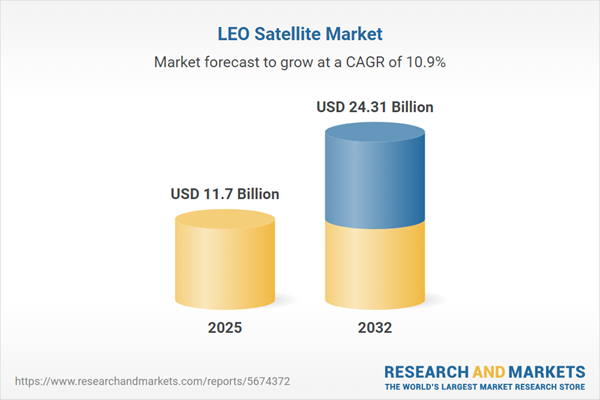Speak directly to the analyst to clarify any post sales queries you may have.
The Low Earth Orbit (LEO) Satellite Market is entering a period of significant transformation, driven by evolving connectivity demands, emerging technologies, and shifting policy landscapes. Strategic decisions in this sector impact not only communications and Earth observation, but also future advancements in navigation, security, and scientific research.
Market Snapshot: LEO Satellite Market Growth and Outlook
The market for LEO satellites is forecast to rise substantially, growing from USD 10.59 billion in 2024 to USD 11.70 billion in 2025. Sustained growth at a CAGR of 10.93% is projected to drive the market to USD 24.31 billion by 2032. This expansion is fueled by rising deployments of small satellite constellations, continuous innovation in launch services, and greater adoption across industries seeking connected solutions, advanced imaging, and enhanced navigation capabilities.
Scope & Segmentation: Diverse Stakeholders and Technological Advancements
The report delivers comprehensive analysis of the LEO satellite ecosystem, offering detailed segmentation spanning missions, subsystems, satellite sizes, operational frequencies, end users, and global regions. Strategic opportunities are identified for organizations across the spectrum:
- Type of Satellite: Communication, Earth Observation, Navigation & Tracking, Remote Sensing, Scientific Research, Surveillance & Reconnaissance, Technology Demonstration
- Subsystem: Payloads, Antenna variants (Array, Horn, Reflector, Wire), Satellite Bus components (Attitude & Orbital Control, Electrical Power, Propulsion), Solar Panels
- Satellite Size: Micro, Mini, Nano
- Frequency Bands: Ka-band, Ku-band, L-band, S-band, UHF
- End User: Academic, Commercial (including Earth observation providers, satellite internet, telecom), Defense (Intelligence, Surveillance, Tactical Communication), Government (Environmental Agencies, National Space Programs)
- Region: Americas (United States, Canada, Mexico, Latin America), Europe, Middle East & Africa (key markets across Europe, Middle East, and Africa), Asia-Pacific (China, India, Japan, Australia, and others)
- Key Companies: Major players include Airbus, Honeywell, L3Harris Technologies, Lockheed Martin, Northrop Grumman, Planet Labs, SpaceX, Thales Group, and others.
The scope includes analysis of democratized satellite access, modular architectures, software-defined payloads, and innovations in both space and ground segments.
Key Takeaways: Strategic Insights for Senior Decision-Makers
- Agile LEO deployments are supplanting traditional timelines, supported by advances in modular satellite design and software enhancements.
- Satellites now offer robust Earth observation, disaster response, navigation, and tracking functions that enhance operational agility across multiple industries.
- Ground segment innovation, including distributed gateways and real-time telemetry, enables improved data management and network resilience.
- Collaborative policy measures and evolving regulatory frameworks are facilitating responsible orbital operations and global spectrum sharing.
- International consortia and joint ventures are driving cross-sectoral innovation, optimizing value through strategic partnerships and expanded service portfolios.
- Emerging end-user segments and growing regional participation are intensifying demand for scalable, reliable LEO satellite solutions.
Tariff Impact: Navigating Policy Changes and Supply Chain Strategies
Recent United States tariffs on critical LEO satellite components have prompted manufacturers to localize production, diversify suppliers, and pursue heightened supply chain resilience. The resulting market environment has driven greater use of additive manufacturing, form factor optimization, and regional sourcing, while incentivizing cross-industry partnerships to mitigate risks and expedite new technology integration.
Methodology & Data Sources
This report is based on a rigorous methodology, combining primary expert interviews, targeted surveys, and workshop sessions with a diverse array of operators, manufacturers, and regulators. Extensive secondary research of peer-reviewed journals, technical white papers, and corporate disclosures complements these findings. Data triangulation and benchmark analysis deliver robust, actionable insight.
Why This Report Matters for LEO Satellite Market Stakeholders
- Offers data-driven intelligence to empower high-impact investment and procurement strategies in the LEO satellite market.
- Facilitates stakeholder alignment by clarifying regulatory trends, cross-sector collaborations, and end-user requirements.
- Supports sustainable ecosystem development by addressing key issues such as orbital safety, supply chain resilience, and technology innovation.
Conclusion
Organizations must leverage modular architectures, diversified supplier strategies, and collaborative alliances to thrive amid changing technologies and policies. This report provides clear guidance for strategic planning and captures the main dynamics shaping the future of Low Earth Orbit satellite initiatives.
Additional Product Information:
- Purchase of this report includes 1 year online access with quarterly updates.
- This report can be updated on request. Please contact our Customer Experience team using the Ask a Question widget on our website.
Table of Contents
3. Executive Summary
4. Market Overview
7. Cumulative Impact of Artificial Intelligence 2025
Companies Mentioned
The companies profiled in this LEO Satellite market report include:- AAC Clyde Space AB
- Airbus S.A.S.
- Honeywell International Inc.
- L3Harris Technologies, Inc.
- Lockheed Martin Corporation
- Millennium Space Systems, Inc. by The Boeing Company
- Mitsubishi Electric Corporation
- Northrop Grumman Corporation
- OHB SE
- Planet Labs PBC
- Raytheon Technologies Corporation by United Technologies Corporation
- Sierra Nevada Corporation
- Spire Global, Inc.
- Surrey Satellite Technology Limited by Airbus SE
- Thales Group
- SpaceX
- Kepler Communications
- OneWeb by Eutelsat Group
- Astranis
- Moog Inc.
- Rafael Advanced Defense Systems Ltd.
- Ariane Group
- SCOUT Space Inc.
- Vyoma Space
Table Information
| Report Attribute | Details |
|---|---|
| No. of Pages | 197 |
| Published | November 2025 |
| Forecast Period | 2025 - 2032 |
| Estimated Market Value ( USD | $ 11.7 Billion |
| Forecasted Market Value ( USD | $ 24.31 Billion |
| Compound Annual Growth Rate | 10.9% |
| Regions Covered | Global |
| No. of Companies Mentioned | 25 |









